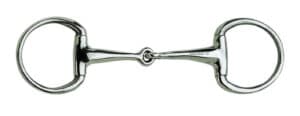When it comes to bits, there are many. But how do you choose the right one? SUZY JARRATT delves into a complex world.
Metal bits were first used during the Bronze and Iron Ages. Before then, mounted tribesmen controlled their horses with primitive bridles made from rope, bone, wood and rawhide.
As the centuries progressed designs evolved, often to the detriment of the horse’s mouth and wellbeing. Nowadays, thankfully, there are bits to simultaneously help make the rider effective and the horse comfortable; and much emphasis is placed on their correct fitting. However, there are still some designs which in unskilled hands can cause lifelong damage.
Saddleries display bits by the dozen, an endless range can be found at on-line equestrian sites, and there are even second hand bits on eBay – but which is appropriate for you considering your riding skills and your horse’s level of training?
In the first of this two-part series, we’ll take a look at some of the simpler bits on the market.
Jointed or non-jointed
Jointed mouthpieces: These feature a break or multiple breaks in the bit and place pressure on specific parts of the mouth. A single joint has only one break and produces a nutcracker action: when the reins are engaged the bit ‘breaks’ and rotates down into the tongue, lips, and bars (the horse’s gums where there are no teeth).
Double-jointed mouthpieces have a link or plate in the middle of the bit, which reduces the nutcracker effect. For this reason, double-jointed bits such as the Lozenge and French Link are typically softer on the mouth.
Non-jointed mouthpiece: A straight or slightly curved solid bar without a break that therefore cannot produce a nutcracker action. In the right hands, these bits are milder than jointed bits. Some non-jointed bits have ports, or raised areas in the centre of the mouthpiece, which can offer tongue relief but may also put pressure on the roof of the mouth.
Loose ring snaffles
The loose ring is the most common type of snaffle, although there are many variations:
Turtle Top: Prevents downward pressure to the tongue encouraging the horse to accept the bit and take the contact forward. The Turtle Top link is also flattened thus reducing palate pressure and restricting movement in the mouthpiece, keeping it still and steady.

Neue Schule Turtle Top Snaffle
Lozenge: With a small peanut-shaped link in the centre of the mouthpiece, this bit is useful for horses who occasionally pull against the hand, but are too sensitive to be ridden with stronger bits.
Pee Wee: Designed in Tasmania, this is a good choice for sensitive mouths. With no palate interference from the floating sweet iron mouthpiece, this design can help with horses which are strong, have fiddly mouths, are head tossers or habitually get their tongue over the bit.

Pee Wee bit
Loose Ring Happy Tongue: A curved and ported solid mouthpiece, which can be helpful when riding a horse with tongue problems, or who goes behind the bit or snatches the reins forward and down.
Happy Mouth: A straight bar, loose rings, and plastic over a central steel core, this can be a good choice when starting young horses due to its warm plastic and steady feel in the mouth. An eggbutt version (see below) is available for horses needing a steadier, consistent feel from their rider, or for those with unsteady hands.

Bombers Full Cheek Happy Tongue
Myler Snaffle: Level 1 is suitable for starting and educating young or green horses; Level 2 produces less tongue pressure than Level 1; and Level 3 offers maximum tongue relief and is suitable for horses with a low palate. Eggbutt versions are also available

Level 1 Myler Eggbutt Snaffle
Neue Schule Verbindend: A sympathetic, ergonomic design helpful for horses who are heavy on the forehand or resistant to the aids. With freedom of the tongue, it assists in lifting from the shoulder and promoting self-carriage.

Neue Schule Verbidend Snaffle
FM Snaffle: Designed by former Australian equestrian coach Franz Mairinger, and also known as a Fulmer. It has the play of a loose ring with the additional directional assistance of full cheeks. It can be used with keepers, which are recommended for safety reasons on children’s ponies.
French Link Pony Eggbutt Snaffle: Similar to the lozenge, this is a small double-jointed stainless steel bit with eggbutt rings, ideal for child riders who are a little unsteady in the hands.
Eggbutt snaffles
The main difference between a loose ring bit and the eggbutt, is that in an eggbutt the cheek is securely fixed to the mouthpiece and cannot move or rotate, making it steadier in the mouth – useful if the horse is being ridden by an unbalanced rider.

Sprenger Stainless Steel Eggbutt

French Link Pony Eggbutt Snaffle
Final thoughts
Remember, size is important when it comes to making your purchase. Consider the shape of your horse’s head and ascertain whether their jaw is wide or narrow. Do they have a fleshy tongue, long or short lips, a high or low palate? If in doubt, consult with a bit fitting specialist, and if you compete, check to see which bits are approved for your events. In our September issue, we’ll navigate around some of the bit world’s more complex designs.
Take a deep dive into the world of bits at Bit Bank Australia and Horse Bit Emporium.



